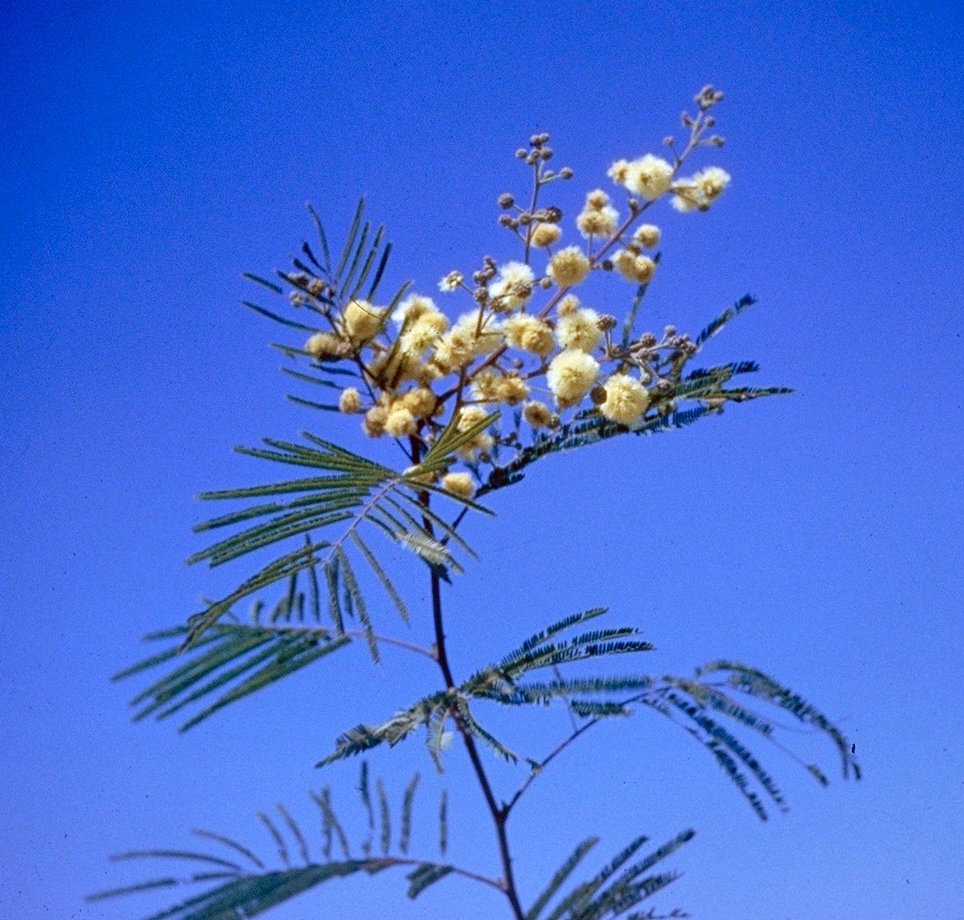Acacia berlandieri
| Height: | ⇕ | 10 ft"ft" can not be assigned to a declared number type with value 10. to 17 ft"ft" can not be assigned to a declared number type with value 17. |
|---|---|---|
| Width: | ⇔ | 10 ft"ft" can not be assigned to a declared number type with value 10. to 17 ft"ft" can not be assigned to a declared number type with value 17. |
| Lifespan: | ⌛ | perennial |
| Bloom: | ❀ | early spring, mid spring, late spring |
| Exposure: | ☼ | sun, part-sun |
|---|---|---|
| Features: | ✓ | flowers |
| USDA Zones: | 8 to 9 | |
| Flower features: | ❀ | white |
|
Fabaceae > |
Acacia > |
| Sunset Zones: | 12, 13, 26-29 |
|---|
Template:About Acacia berlandieri (Berlandier Acacia, Guajillo Acacia, guajillo, huajillo) is a shrub native to the Southwestern United States that belongs to the Mimosaceae (wattle family). It grows 1m to 5m tall, with blossoms that are spherical and white, occurring from February through April.[1] The berlandieri epithet comes from the name of Jean-Louis Berlandier[2], a French naturalist who studied wildlife native to Texas and Mexico. A. berlandieri contains a wide variety of alkaloids and has been known to cause toxic reactions in domestic animals such as goats.[3]
Cultivation
Propagation
Pests and diseases
Uses
A. berlandieri is toxic to livestock and thus should not be used as forage or fodder.[4]
Alkaloids
A. berlandieri contains a number of diverse alkaloids, the most plentiful of which are N-methylphenethylamine, tyramine, and phenethylamine. In a recent study, researchers identified thirty-one alkaloids in samples of plant foliage, including trace amounts of five amphetamines previously believed to be human inventions:[5] amphetamine, methamphetamine, N,N-dimethylamphetamine, p-hydroxyamphetamine and p-methoxyamphetamine. Other trace alkaloids include DMT (found in many related species), nicotine, and mescaline (found in many cacti but infrequently in other plants). The same group of researchers later reported finding most of the same alkaloids in A. rigidula, a related species also native to the Southwestern U.S. The findings, however, have never been confirmed or repeated, leading some researchers to believe the results were the result of cross-contamination.
History
Taxonomy
| Scientific classification | ||||||||||||||||||||||||||||||||||||||||||||||||||||||||||||||||||
|---|---|---|---|---|---|---|---|---|---|---|---|---|---|---|---|---|---|---|---|---|---|---|---|---|---|---|---|---|---|---|---|---|---|---|---|---|---|---|---|---|---|---|---|---|---|---|---|---|---|---|---|---|---|---|---|---|---|---|---|---|---|---|---|---|---|---|
| ||||||||||||||||||||||||||||||||||||||||||||||||||||||||||||||||||
| [[{{{diversity_link}}}|Diversity]] | ||||||||||||||||||||||||||||||||||||||||||||||||||||||||||||||||||
| {{{diversity}}} | ||||||||||||||||||||||||||||||||||||||||||||||||||||||||||||||||||
| Binomial name | ||||||||||||||||||||||||||||||||||||||||||||||||||||||||||||||||||
| Acacia berlandieri Benth. | ||||||||||||||||||||||||||||||||||||||||||||||||||||||||||||||||||
| Trinomial name | ||||||||||||||||||||||||||||||||||||||||||||||||||||||||||||||||||
| {{{trinomial}}} | ||||||||||||||||||||||||||||||||||||||||||||||||||||||||||||||||||
| Type Species | ||||||||||||||||||||||||||||||||||||||||||||||||||||||||||||||||||
| {{{type_species}}} | ||||||||||||||||||||||||||||||||||||||||||||||||||||||||||||||||||
| {{{subdivision_ranks}}} | ||||||||||||||||||||||||||||||||||||||||||||||||||||||||||||||||||
 Range of Acacia berlandieri | ||||||||||||||||||||||||||||||||||||||||||||||||||||||||||||||||||
| Synonyms | ||||||||||||||||||||||||||||||||||||||||||||||||||||||||||||||||||
| {{{synonyms}}} |
Distribution and habitat
References
- ↑ University of Texas Native Plant Information Network
- ↑ Holloway, Joel Ellis (2005). A Dictionary of Common Wildflowers of Texas & the Southern Great Plains. Texas Christian University Press. ISBN 354063293X.
- ↑ Clement, Beverly A.; Christina M. Goff and T. David A. Forbes (September 1997). "Toxic amines and alkaloids from Acacia berlandieri". Phytochemistry (Elsevier) 46 (2): 249–254. doi:10.1016/S0031-9422(97)00240-9. http://www.sciencedirect.com/science?_ob=ArticleURL&_udi=B6TH7-3SCB6WX-1N&_user=10&_coverDate=09%2F30%2F1997&_rdoc=1&_fmt=&_orig=search&_sort=d&view=c&_acct=C000050221&_version=1&_urlVersion=0&_userid=10&md5=b215a5ead4e2fc6cc27a4cf30ced3f5e. Retrieved 2007-04-01.
- ↑ Texas Toxic Plants
- ↑ Ask Dr. Shulgin Online: Acacias and Natural Amphetamine






